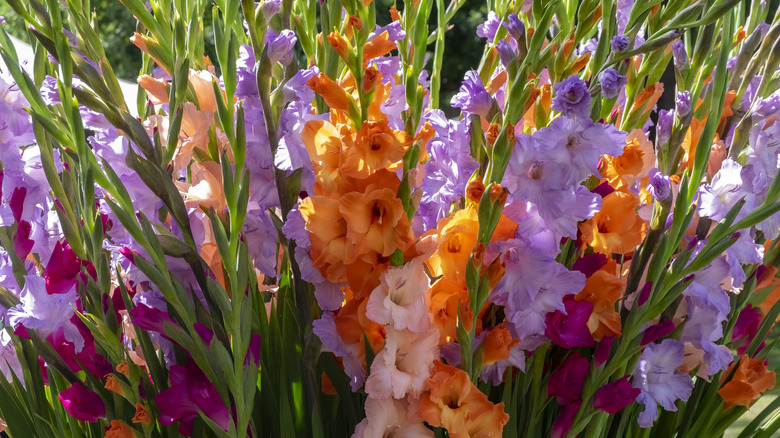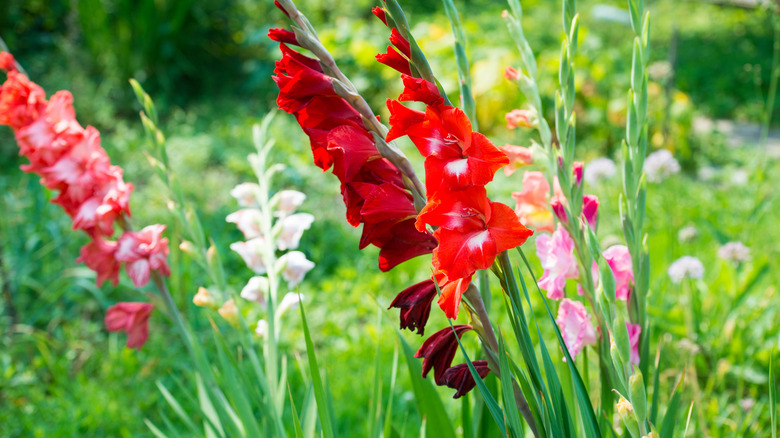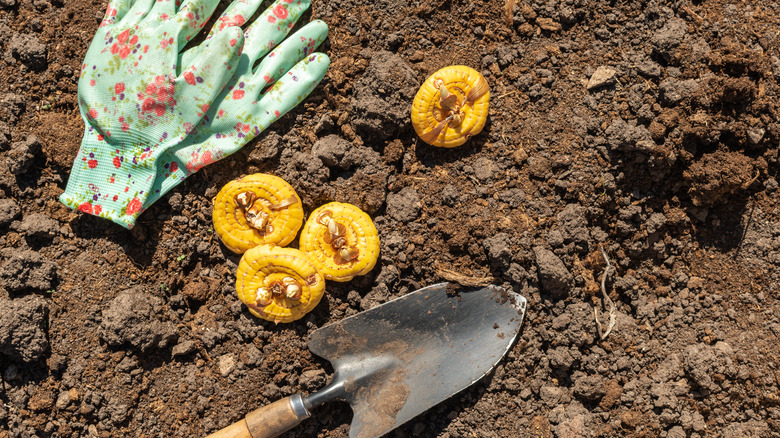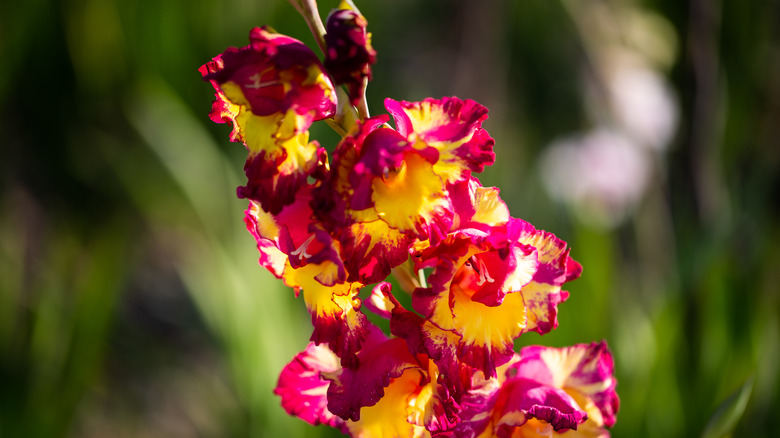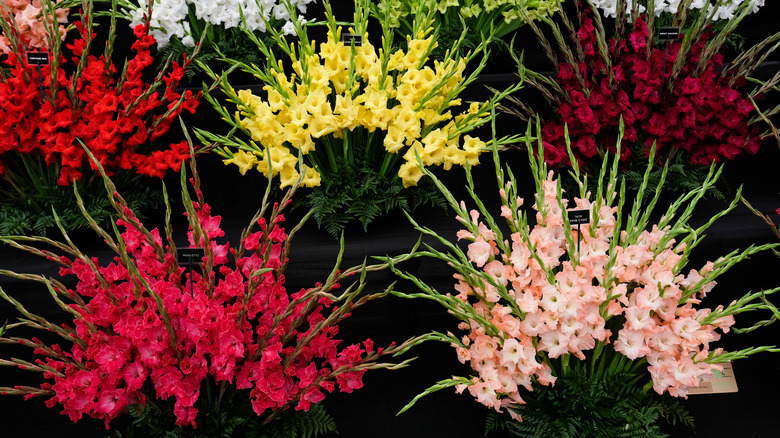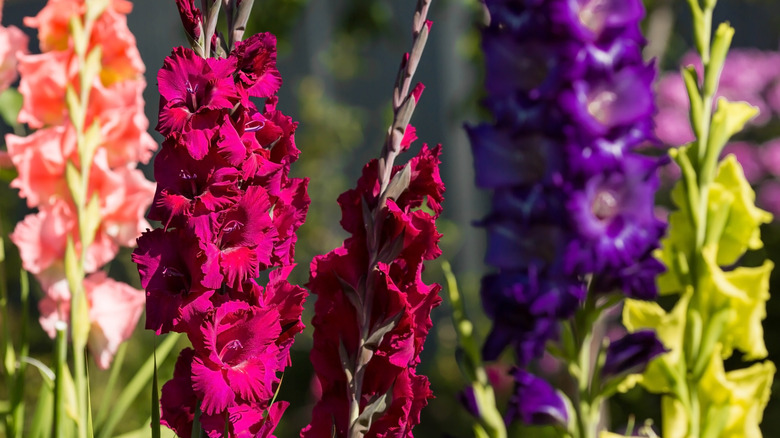Gladiolus: Everything You Should Know Before Planting
Maybe you know them as sword lilies, or perhaps you've heard them called "glads" for short. Many people call them by their scientific name: gladiolus. Their name actually comes from the Latin word "gladius," which means sword, explains The Old Farmer's Almanac. These gorgeous flowering perennials are known for their height and prolific blooms, plus they're low maintenance and easy to grow.
If you're thinking of a certain color, you can probably find a gladioli variety to match. From deep burgundies to sunny yellows to cheerful pinks to fiery reds to vibrant purples and nearly everything in between, there are over 250 species available. Most are native to Europe and South Africa, according to American Meadows.
When it comes to size, the height and flower diameter will vary based on the particular type you choose. The height can range from two to five feet, with flower diameters starting around two inches for mini varieties up to nearly six inches for larger varieties.
How to use gladiolus in the garden
Because of their height, many gardeners choose to place gladiolus in the back of the flower bed. This allows for interesting contrast and gives the garden depth if you pair them with smaller, mounding plants in front. American Meadows suggests planting at least ten gladiolus together in one location to create a dramatic effect. Besides aesthetics, there's actually a more practical reason for doing this, too. Because of their height and thin stalks, gladiolus can fall over easily. By planting them in a large group, they can support each other and thus, be less likely to topple over.
Gladiolus are an extremely popular cut flower, so some gardeners just choose to plant them in their cutting garden. They make a great addition to summer bouquets and displays. If you decide to go the cutting garden route with your glads, The Old Farmer's Almanac says it's best to plant them in rows. This will make it easier to access and snip them for harvesting, and tend to any needs that may arise.
How to grow gladiolus
Successfully growing gladiolus begins with choosing good corms. You want them to be firm, not soft or squishy. They should be plump, so avoid any that have a shriveled appearance. Finally, try to choose the biggest ones you can. Gardenia explains that this is because corm size is directly related to plant size. Additionally, large corms can bloom 10 to 15 days sooner than their smaller counterparts.
You can plant your corms beginning in the spring (just wait until the last frost has passed) all the way up through the early summer. For large corms, space them approximately five inches apart and between four to six inches deep in the soil. Smaller corms can be planted at a depth of two to three inches. It's recommended that you keep your corms close together so they'll act as the natural support system we mentioned above. If you choose not to, you'll need to add stakes at the time of planting to ensure they're adequately supported.
When you place the corms in the ground, make sure the pointed end is facing up. Then, cover with soil, press down firmly, and give the area a good watering.
How to care for gladiolus
When you're choosing a planting location, make sure it's somewhere sunny, as gladiolus thrive in full sun. They're not too picky when it comes to soil, so you don't need to worry about amending it unless it's heavy on the clay side. However, Gardenia says you'll want to keep the soil moist because dried out soil can affect the size of your spikes, flowers, and corms for next year. Adding a layer of mulch will help retain some of the moisture and form a barrier against weeds. Once your gladiolus blooms, you can ease up on the watering.
The Old Farmer's Almanac recommends removing spent flowers to maintain continuous blooming. Then, once all the flowers on the stalk are spent, you should trim the stalk so it's only a couple of inches tall. Leave the plant alone after you've trimmed it down. This will safeguard the corms and ensure they can properly mature for the next season's blooms.
Varieties of gladiolus
When buying an assorted bag of corms, you won't have much control over the colors or sizes. However, many online nurseries offer rare varieties that can be shipped to you, so you're sure to find something that will give you the most unique gladiolus on the block.
If stunning and statement-making is what you're after, check out these varieties:
-
Gladiolus Elvira - Maybe named for the 1980s Mistress of the Dark, this particular Elvira features a white flower with reddish-pink markings on the petals that actually look like a kiss. Its height reaches 20 to 30 inches.
-
Gladiolus Atom - Bursting with fiery red blossoms, this variety surprises with a delicate, white outline trimming each flower. It was introduced in 1946 and has been popular ever since. Its height reaches 30 to 36 inches.
-
Gladiolus Finishing Touch - If you want everything to be peachy keen in your garden, this is the flower for you. Its blossoms are a delightful shade of peachy orange, with faint yellow centers. Its height reaches 48 to 60 inches.
-
Gladiolus Black Surprise - These velvety blooms are such a deep shade of burgundy that they almost look black. They'll add a touch of mystery and drama to your garden, and their height reaches 36 to 48 inches.
- Gladiolus Jester - Like its fun, cheery name suggests, this variety features bright yellow flowers with an unexpected red accent on the lower half of each bloom. Its height reaches 36 to 48 inches.
Toxicity, common diseases, and problems with gladiolus
While it's hard to resist a fresh bouquet of gladiolus to brighten up your home, you'll need to resist if you have cats or dogs. According to the ASPCA, ingestion can cause vomiting, lethargy, and diarrhea. The corms contain the highest concentration of toxins, so it's important to keep these stored up high and out of reach of your dogs or cats.
Now that you know to keep your flowers and corms away from your pets, make sure to watch out for these other common problems that can plague your gladiolus. The Old Farmer's Almanac says that corm rot — also called fusarium wilt — impacts the corms, as the name explains, but you'll actually see the plant impacted too. Its growth may shrink or cease, and yellowing leaves are a telltale sign that the roots are dying below the surface.
When it comes to pests, watch out for aphids, spider mites, and thrips. For both aphids and spider mites, fill a spray bottle with icy cold water and spritz it all over the leaves when you see the critters. Thrips are more challenging to control; Old House Gardens suggests a nontoxic method first and says to place sticky traps on stakes next to your glads. If this doesn't work, you'll need to apply an insecticide before your gladiolus begin blooming.
